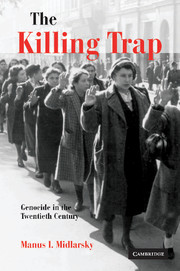Book contents
- Frontmatter
- Contents
- Preface
- PART I Introduction
- PART II Explaining perpetrators: theoretical foundations
- 3 Continuity and validation
- 4 Prologue to theory
- 5 A theoretical framework
- PART III The theory applied
- PART IV Victim vulnerability: explaining magnitude and manner of dying
- PART V Exceptions
- PART VI Conclusion
- References
- Index
5 - A theoretical framework
Published online by Cambridge University Press: 22 September 2009
- Frontmatter
- Contents
- Preface
- PART I Introduction
- PART II Explaining perpetrators: theoretical foundations
- 3 Continuity and validation
- 4 Prologue to theory
- 5 A theoretical framework
- PART III The theory applied
- PART IV Victim vulnerability: explaining magnitude and manner of dying
- PART V Exceptions
- PART VI Conclusion
- References
- Index
Summary
Having eliminated two candidates for explanation, and seeing intimations of possibility in others as the result of our test cases, we turn directly to theory development. Realpolitik as management of threats to the state and losses as signals of state vulnerability now occupy our attention. Realpolitik is understood as policies that preserve and strengthen the state, while loss is the experience of either (1) transfer of territory, population, authority, or some combination thereof to another political entity, or (2) military defeat or significant casualties in political violence (e.g., war) that either are about to be or have already been incurred. Concrete expectations of loss in the near term can yield outcomes similar to those of loss itself. In later analyses, I will find it useful to distinguish between threat and loss, whereby threat can be understood as the fear of potential loss. This understanding will be useful later in distinguishing between conflicts that result in ethnic cleansing, and those that proceed further to genocide.
Brute force (imprudent) realpolitik entailing disproportionate responses to perceived provocation, to be defined more completely below, and prospect theory emphasizing the salience of loss are introduced as means of understanding the transformation of massacre into genocide within the context of earlier state losses and high risk. Prospect theory will also be described in more detail. Massacre, unfortunately, is not an uncommon occurrence. While massacre may originate in many different ways, its transformation into genocide is complex and therefore infrequent.
- Type
- Chapter
- Information
- The Killing TrapGenocide in the Twentieth Century, pp. 83 - 110Publisher: Cambridge University PressPrint publication year: 2005



